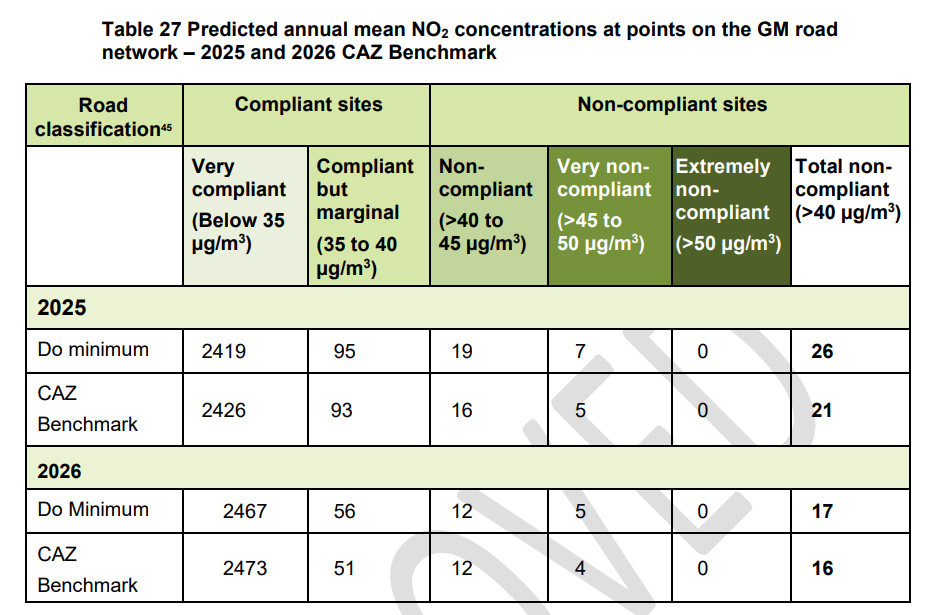Mayor Andy Burnham once vowed to never introduce a clean air zone (CAZ) to tackle toxic air pollution; authorities in Greater Manchester have delivered on this by modelling a highly limited version that made almost no impact, an investigation by Highways has revealed.
The region has a large number of areas with illegal levels of toxic nitrogen dioxide (NO2), which mainly comes from vehicles.
The overall health burden of air pollution is linked to the equivalent of 40,000 premature deaths in the UK every year - measured in 'years of life lost' as a result of particulate pollution.
Under the Air Quality Directive local authorities are required to take action to bring levels within legal levels ‘in the shortest possible time’.
However, despite these legal obligations, Mr Burnham – a former health secretary – has been a longstanding opponent of measures to address air pollution through charging drivers of more polluting vehicles.
In 2017, he told the BBC: 'I have no intention of introducing charges on the ordinary motorist.’
In 2022, he persuaded ministers to revoke a direction to introduce a regional Class C CAZ ‘so as to achieve compliance with the legal limit value for NO2 in the shortest possible time and by 2024 at the latest’ and allow local authorities to explore other options with a new target date of 2026.
And in December 2023, he pledged on BBC Radio Manchester that he would never introduce charges for vehicles as mayor.
Damn lies and Defra
In January, the Government announced that it would allow Greater Manchester Combined Authority (GMCA), on behalf of the region’s 10 highway authorities, to rely solely on an £86m ‘investment-led' approach, mainly improving its ‘Bee Network’ public transport.
Environment department Defra said that it and the Department for Transport had ‘rigorously assessed’ Manchester’s approach and concluded it will meet legal obligations to ‘reduce nitrogen dioxide pollution’, adding that GMCA had ‘provided evidence they can achieve compliance with legal limits faster without charging’.
This last statement does not stand up to scrutiny. Not only is it illogical to suggest that measures to reduce vehicle emissions would slow down compliance with pollution limits, but it appears that the GMCA never considered a scenario where it would implement its ‘investment-led’ plan alongside a CAZ.
In fact, in order to demonstrate that its ‘investment-led’ plan, would achieve compliance quicker than a CAZ, GMCA was allowed to ‘benchmark’ it against a Class C CAZ only covering Manchester and Salford, which does not charge private vehicles, rather than a Class D CAZ, which does.
As a result, an appraisal document produced by GMCA’s transport arm, Transport for Greater Manchester (TfGM) claimed that the ‘investment-led’ plan would achieve region-wide compliance with the legal limits in 2026 but that the benchmark CAZ would not.
In fact, the appraisal claimed that the ‘benchmark’ CAZ would be almost entirely ineffective, even if it could be implemented for the whole of 2026, with 16 sites exceeding legal limits, compared with 17 exceedances under a 'do minimum' scenario.

Cutting corners on compliance?
Last October, Mr Burnham wrote to the environment and transport secretaries on behalf of the GMCA’s constituent authorities, attaching its modelling and stated: ‘The appraisal shows that only the investment-led plan complies with the requirement placed on the 10 Greater Manchester Authorities to deliver compliance with legal limits for NO2 on local roads in the shortest possible time and by 2026 at the latest.’
However, unless he also assessed that neither a Class D CAZ alone nor adding any class of CAZ to the ‘investment-led' approach would accelerate compliance, he would have no basis for asserting that the ‘investment-led’ plan alone would ‘deliver compliance…in the shortest possible time’.
Highways asked the GMCA to clarify whether Mr Burnham considered the same ‘investment-led approach’ in addition to class C or D CAZs would be quicker than the ‘investment-led’ approach alone.
It did not answer this question but TfGM stated that this ‘wasn’t a requirement from the government’.
Defra has said that it is the role of local authorities to determine the quickest and most effective way to meet legally-binding targets to reduce nitrogen dioxide levels.
Defra also told Highways that ‘local authorities are required to consider whether there are alternatives available that would deliver legal levels of NO2 at least as quickly as a Clean Air Zone’ but did not respond to a request to explain why it incorrectly presented measures other than a CAZ as ‘alternatives’ rather than potentially additional to a CAZ.
Following last month’s announcement, the Let Manchester Breathe coalition said that the agreed plan, ‘cannot be considered satisfactory, especially as Manchester and Salford rank in the top ten for highest number of emergency admissions and deaths for lung conditions across the UK’.
It pointed out that the latest Defra statistics show that Manchester has consistently the highest annual mean level of NO2 in the country.
This has increased by 6% since 2021 and Manchester is the only local authority that was designated as being in exceedance of legal limits in 2021 that is continuing to see an upward trajectory.
Cazz Ward of Walk Ride Greater Manchester said: ‘We fully support the roll-out of the Bee Network but the GM Clean Air Plan is in no way ambitious enough to reduce the high levels of NO2 in GM and the risks of not achieving even these later deadlines are huge.
‘Car ownership in Manchester is rising at more than twice the national rate [while] in those cities that have introduced CAZs, the number of diesel vehicles with high emissions is significantly dropping, along with decreasing levels of NO2.
‘An integrated public transport network is not enough to enable modal shift to change behaviour from choosing trips by private motor vehicle as the default. Short journeys made by private motor vehicles and driving to the city centre must be disincentivised with strong policy.'





